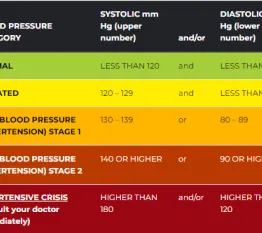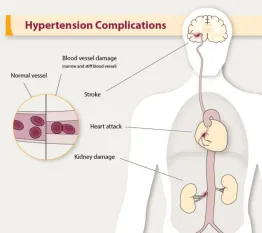Manage High Blood Pressure

When we think about a healthy lifestyle, we think about incorporating healthy habits into our daily life, such as working out, eating a balanced diet, and drinking water. Although all of these are important factors, we might be missing another healthy habit – monitoring our blood pressure. Maintaining healthy blood pressure is an important part of taking care of your body.
Healthy and Unhealthy Blood Pressure Ranges
According to the American Heart Association, almost half of American adults have high blood pressure and may not know it. High blood pressure, also called hypertension, is blood pressure that is higher than normal and because hypertension has no symptoms to indicate that something is wrong, the only way to diagnose it is by having your blood pressure tested by a medical professional.
There are five blood pressure ranges as recognized by the American Heart Association – normal, elevated, hypertension stage 1, hypertension stage 2, and hypertensive crisis.

High Blood Pressure Complications
High blood pressure can damage your health in many ways. According to the Centers for Disease Control and Prevention (CDC), hypertension can seriously hurt important organs like your heart, brain, kidneys, and eyes. Since blood pressure is the pressure of blood pushing against the walls of your arteries, hypertension directly affects your heart health. It can decrease the flow of blood and oxygen to your heart and can lead to a heart attack or heart disease. Arteries also supply blood and oxygen to the brain, so hypertension increases the risk of a stroke or brain problems as it can directly affect the elasticity of the arteries. Another complication hypertension can cause chronic kidney disease, especially if the person also has diabetes.

Steps to Manage High Blood Pressure
The good news is that many people with high blood pressure can enter into a healthy range by making lifestyle changes. The CDC recommends the following steps to help manage your blood pressure and lower the risk for further health problems, such as heart disease and stroke.
1. Measure Your Blood Pressure on a Regular Basis.
Because high blood pressure and elevated blood pressure often have no symptoms, checking your blood pressure is the only way to keep a record of your blood pressure range.
The YMCA offers a Blood Pressure Self-Monitoring program that is designed to help adults with hypertension lower and manage their blood pressure. The four-month program focuses on regular home self-monitoring of one’s blood pressure using proper measuring techniques, one-on-one consultations with a trained Healthy Heart Ambassador, individualized support and group-based nutrition education for better blood pressure management. You can learn more about this program and check if you qualify here. Receive 50% off your program fee if you register before March 31, 2022.
2. Make Lifestyle Changes.
If you have high blood pressure, you can help lower it by being physically active, eating a healthy diet, and making other lifestyle changes.
3. Manage Diabetes.
According to the CDC, 6 out of 10 people with diabetes also have high blood pressure. If you have diabetes, monitor your blood glucose (also called blood sugar) levels carefully and talk with your health care team about treatment options.
The YMCA of Greensboro offers a Diabetes Prevention Program that uses a CDC-approved curriculum and is part of the CDC-led National Diabetes Prevention Program. This 25-session program helps those at high risk of developing type 2 diabetes adopt and maintain healthy lifestyles.
4. Follow Your Health Care Professional’s Instructions.
If you take medicine to treat high blood pressure or other health conditions, follow your doctor’s or health care professional’s instructions carefully. Always ask questions if you do not understand something, and never stop taking your medicine without talking with your doctor or pharmacist first.
Remember that your lifestyle choices can increase or decrease your risk of high blood pressure. Some behaviors that can increase your high blood pressure, according to the American Heart Association, are unhealthy diets that are high in sodium, physical inactivity, obesity and too much alcohol or tobacco use. Genes also play some role in high blood pressure and other related conditions.
Incorporating new healthy habits into your daily life can be challenging. Change is hard, but Y is here to help you! With specialty programs such as our Blood Pressure Self-Monitoring Program and Diabetes Prevention Program, you don’t have to take the steps into a healthier lifestyle alone.
To learn more and register for any of these programs, contact Angela Rogers or call (336) 478-9622.
Resources
- Understanding Blood Pressure; American Heart Association. Understanding Blood Pressure Readings | American Heart Association
- Prevent High Blood Pressure; CDC. Prevent High Blood Pressure | cdc.gov
- Manage High Blood Pressure; CDC. Manage High Blood Pressure | cdc.gov
- Know Your Risk for High Blood Pressure; CDC. Know Your Risk for High Blood Pressure | cdc.gov